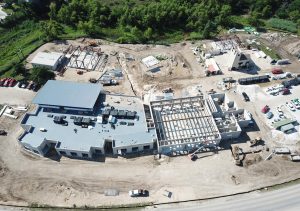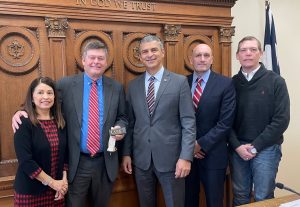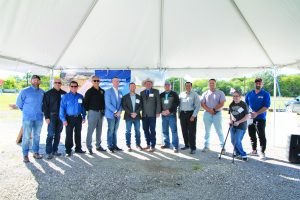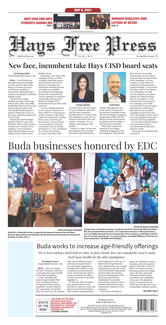By Moses Leos III
A crowd of more than 600 showed up at Bowie High last Tuesday for TxDOT’s public hearing on the Environmental Impact Statement draft for State Highway 45SW (SH 45SW).
The hearing drew hundreds of supporters and some vocal opponents of the controversial road.
“I’m surprised that so many people for the road came out,” Hays County Pct. 2 Commissioner Mark Jones said. “What you see tonight is Travis County [residents] coming out [in support of SH 45SW].”
State Highway 45SW is a proposed four-mile long four-lane toll road that would connect FM 1626 close to Lakewood Drive in Hays County to MoPac Expressway near Slaughter Lane in Austin. The project will directly impact 159 acres of land.
According to the draft EIS, the tollway would have “little impact” to nearby neighborhoods. No effect is anticipated to endangered wildlife such as the golden cheek warbler and the Barton Springs blind salamander.
However, the study — indeed the overall project — had its opponents, including Save Our Springs (SOS) Executive Director Bill Bunch. He asked TxDOT during his three-minute public comment to withdraw and resubmit the EIS.
He said the most important environmental studies on the karsts and geological formations are ongoing. He also said the roadway did not have preliminary designs to warrant a “meaningful” public comment.
He said TxDOT could resubmit the EIS, but only after they add certain elements, including specifying road alignment, designs on control systems and water quality measures.
“They can republish it at that time, then have a meaningful public comment and do a final EIS,” Bunch said.
But proponents of the roadway were just as steadfast in their support for the project.
Speaking in support were Buda Mayor Todd Ruge and Hays County Emergency Service District No. 8 Chief Clay Huckaby.
Huckaby noted the road’s ability to hasten response times during emergency calls. SH 45SW, he said, would cut down the time for first responders to run patients to hospitals in Austin. He said the ambulance currently takes IH-35, which can become bogged down during rush hours.
That reasoning didn’t sway Circle C subdivision resident Mike Tenorio, who said he felt the study was incomplete. He said other options were needed rather than just a no-build scenario.
“I think they need to do more homework and look at the total picture,” Tenorio said. “Moving the traffic jam from one part of town to anther part doesn’t seem like a solution to me.”
Bob Larsen, board vice president of the Barton Springs Edward’s Aquifer Conservation District, said the draft EIS is a “good beginning document.”
However, he said some shortcomings, such as the karst surveys, must be addressed. SH 45SW is projected to affect seven karst features, or underground caves, four of which are “sensitive.”
Larsen said he will keep to the BSEACD’s consent decree, which would give the district’s consent, but only if the roadway is done in an “environmentally safe manner.”
“They (TxDOT) have to prove to us that it can be done and done right,” Larsen said.
Commissioner Jones, though, said the road was “the most environmentally sound road in the state” and he thought the draft EIS was sufficient. He pointed to the efforts TxDOT is going through to assess karst features.
“We have done the research. [TxDOT knows] where they are. We think we can mitigate and protect those,” Jones said. “But there are some karst features on Brodie Lane that are unprotected that we are driving over every day. There are more karst [affected] in those sections than on (SH 45SW).”
Mary Kelly-Dillon, board member of the Hays Country Oaks Homeowners Association (HOA), had several concerns regarding the environmental findings, including adding flyovers to ease congestion onto SH 45SW. She said she feels “comfortable” with the EIS, provided several changes are made.
For Kelly-Dillon, the road is an important cog to alleviating the nearly three hours she waits in Austin traffic.
“It’s unconscionable for Austin to allow for the status quo to continue,” she said. “As we get to next phase, as we get an ironed out version, I am feeling more comfortable that we’ll have the issues ironed out.”
TxDOT promises environmental protections on SH 45SW
While the report drew praise and criticism, TxDOT’s Environmental Impact Statement (EIS) draft is the first step toward the projected $100 million road’s construction.
The crux of TxDOT’s study stemmed over water quality issues. Nearly 90 percent of the roadway would be constructed in the Barton Springs Edwards Aquifer recharge zone.
TxDOT’s study claims water quality protection measures, deemed Best Management Practices (BMP), would remove 90 percent of the total suspended solids (TSS) generated during construction.
BMP’s include the use of Permeable Friction Course pavement, water quality ponds and hazardous material traps.
“The BMPs we are using to protect karst features and water quality include the latest technologies and are planned to exceed the requirements of the Texas Commission on Environmental Quality’s regulations that protect the Edwards Aquifer,” Carlos Swonke, director of environmental affairs at TxDOT said in an emailed response.
In addition, the project would not require any anticipated acquisition of state right-of-way, nor does it affect Austin Water Quality Protected Lands (WQPL).
However, Swonke stressed the EIS is still a draft and input will continue before a final decision is made.
That includes one ongoing survey on karst features affected by the project. Swonke said it would help supplement TxDOT’s initial karst investigation in 2007.
“It is not unusual to have ongoing field studies, at this point,” Swonke said. “The key element is to have substantial issues identified in the draft report for decision-making and public disclosure purposes. The limited, remaining work currently being done is not expected to change the findings.”
Swonke was pleased with the “turnout and the thoughtful comments” made at the July 29 meeting.
However, he said TxDOT is not planning for more public involvement.
“At this time, we are not planning for another public hearing; however, we need to evaluate the comments on the Draft EIS before moving forward,” Swonke said. “If there are any substantial changes in what we’ve presented so far, we would consider additional public involvement.”










